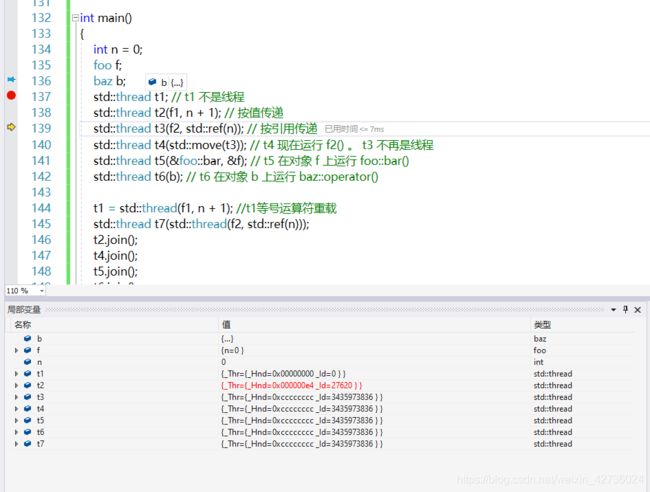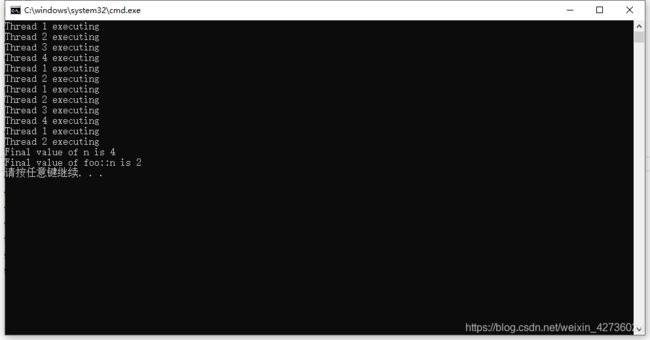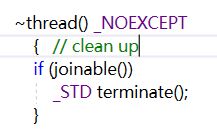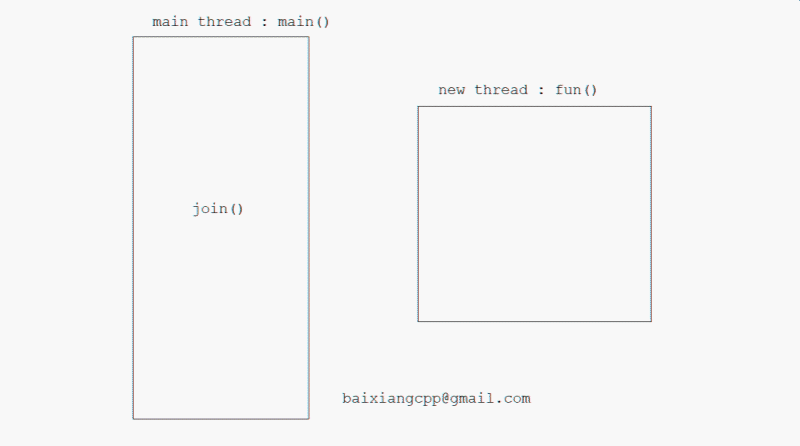C++ thread用法总结(整理)
1,简介
C++11中加入了
std::thread类成员函数:
(1)、get_id:获取线程ID,返回一个类型为std::thread::id的对象。
(2)、joinable:检查线程是否可被join。检查当前的线程对象是否表示了一个活动的执行线程。缺省构造的thread对象、已经完成join的thread对象、已经detach的thread对象都不是joinable。
(3)、join:调用该函数会阻塞当前线程(主调线程)。阻塞调用者(caller)所在的线程(主调线程)直至被join的std::thread对象标识的线程(被调线程)执行结束。
(4)、detach:将当前线程对象所代表的执行实例与该线程对象分离,使得线程的执行可以单独进行。一旦线程执行完毕,它所分配的资源将会被释放。
(5)、native_handle:该函数返回与std::thread具体实现相关的线程句柄。native_handle_type是连接thread类和操作系统SDK API之间的桥梁,如在Linux g++(libstdc++)里,native_handle_type其实就是pthread里面的pthread_t类型,当thread类的功能不能满足我们的要求的时候(比如改变某个线程的优先级),可以通过thread类实例的native_handle()返回值作为参数来调用相关的pthread函数达到目录。This member function is only present in class thread if the library implementation supports it. If present, it returns a value used to access implementation-specific information associated to the thread.
(6)、swap:交换两个线程对象所代表的底层句柄。
(7)、operator=:moves the thread object
(8)、hardware_concurrency:静态成员函数,返回当前计算机最大的硬件并发线程数目。基本上可以视为处理器的核心数目。
另外,std::thread::id表示线程ID,定义了在运行时操作系统内唯一能够标识该线程的标识符,同时其值还能指示所标识的线程的状态。Values of this type are returned by thread::get_id and this_thread::get_id to identify threads.
有时候我们需要在线程执行代码里面对当前调用者线程进行操作,针对这种情况,C++11里面专门定义了一个命名空间this_thread,此命名空间也声明在
1.创建一个线程
创建线程比较简单,使用std的thread实例化一个线程对象就创建完成了,示例:
#include
#include
#include //sleep
using namespace std;
void t1() //普通的函数,用来执行线程
{
for (int i = 0; i < 10; ++i)
{
cout << "t1111\n";
sleep(1);
}
}
void t2()
{
for (int i = 0; i < 20; ++i)
{
cout << "t22222\n";
sleep(1);
}
}
int main()
{
thread th1(t1); //实例化一个线程对象th1,使用函数t1构造,然后该线程就开始执行了(t1())
thread th2(t2);
th1.join(); // 必须将线程join或者detach 等待子线程结束主进程才可以退出
th2.join();
//or use detach
//th1.detach();
//th2.detach();
cout << "here is main\n\n";
return 0;
} 上述提到的问题,还可以使用detach来解决,detach是用来和线程对象分离的,这样线程可以独立地执行,不过这样由于没有thread对象指向该线程而失去了对它的控制,当对象析构时线程会继续在后台执行,但是当主程序退出时并不能保证线程能执行完。如果没有良好的控制机制或者这种后台线程比较重要,最好不用detach而应该使用join。
2, mutex和std::lock_guard的使用
头文件是#include
但使用lock_guard则相对安全,它是基于作用域的,能够自解锁,当该对象创建时,它会像m.lock()一样获得互斥锁,当生命周期结束时,它会自动析构(unlock),不会因为某个线程异常退出而影响其他线程。示例:
#include
#include
#include
#include
int cnt = 20;
std::mutex m;
void t1()
{
while (cnt > 0)
{
std::lock_guard lockGuard(m);
// std::m.lock();
if (cnt > 0)
{
//sleep(1);
--cnt;
std::cout << cnt << std::endl;
}
// std::m.unlock();
}
}
void t2()
{
while (cnt > 0)
{
std::lock_guard lockGuard(m);
// std::m.lock();
if (cnt > 0)
{
--cnt;
std::cout << cnt << std::endl;
}
// std::m.unlock();
}
}
int main(void)
{
std::thread th1(t1);
std::thread th2(t2);
th1.join(); //等待t1退出
th2.join(); //等待t2退出
std::cout << "here is the main()" << std::endl;
return 0;
} 输出结果,cnt是依次递减的,没有因为多线程而打乱次序::
19
18
17
16
15
14
13
12
11
10
9
8
7
6
5
4
3
2
1
0
here is the main()
3,详解
绍一下thread的用法。
std::thread 构造函数
| thread() noexcept; | (1) | (C++11 起) |
| thread( thread&& other ) noexcept; | (2) | (C++11 起) |
| template< class Function, class... Args > explicit thread( Function&& f, Args&&... args ); |
(3) | (C++11 起) |
| thread(const thread&) = delete; | (4) | (C++11 起) |
构造新的 thread 对象。
1) 构造不表示线程的新 thread 对象。
2) 移动构造函数。构造表示曾为 other 所表示的执行线程的 thread 对象。此调用后 other 不再表示执行线程。
3) 构造新的 std::thread 对象并将它与执行线程关联。新的执行线程开始执行
4) 复制构造函数被删除; thread 不可复制。没有两个 std::thread 对象可表示同一执行线程。
std::thread::~thread
| ~thread(); |
(C++11 起) |
在下列操作后 thread 对象无关联的线程(从而可安全销毁)
- 被默认构造
- 被移动
- 已调用 join()
- 已调用 detach()
std::thread::operator=
| thread& operator=( thread&& other ) noexcept; |
(1) | (C++11 起) |
这个例子是借鉴cppreference.com这个网站上面的,我详细的分析一下这个例子。
#include
#include
#include
#include
void f1(int n){
for (int i = 0; i < 2; ++i) {
std::cout << "Thread 1 executing\n";
++n;
std::this_thread::sleep_for(std::chrono::milliseconds(10));
}
}
void f2(int& n){
for (int i = 0; i < 2; ++i) {
std::cout << "Thread 2 executing\n";
++n;
std::this_thread::sleep_for(std::chrono::milliseconds(10));
}
}
class foo{
public:
void bar(){
for (int i = 0; i < 2; ++i) {
std::cout << "Thread 3 executing\n";
++n;
std::this_thread::sleep_for(std::chrono::milliseconds(10));
}
}
int n = 0;
};
class baz{
public:
void operator()(){
int n = 0;
for (int i = 0; i < 2; ++i) {
std::cout << "Thread 4 executing\n";
++n;
std::this_thread::sleep_for(std::chrono::milliseconds(10));
}
}
};
int main(){
int n = 0;
foo f;
baz b;
std::thread t1; // t1 不是线程
std::thread t2(f1, n + 1); // 按值传递
std::thread t3(f2, std::ref(n)); // 按引用传递
std::thread t4(std::move(t3)); // t4 现在运行 f2() 。 t3 不再是线程
std::thread t5(&foo::bar, &f); // t5 在对象 f 上运行 foo::bar()
std::thread t6(b); // t6 在对象 b 上运行 baz::operator()
t1 = std::thread(f1, n + 1); //t1等号运算符重载
std::thread t7(std::thread(f2, std::ref(n))); //t7拷贝构造
t2.join();
t4.join();
t5.join();
t6.join();
t1.join();
t7.join();
std::cout << "Final value of n is " << n << '\n';
std::cout << "Final value of foo::n is " << f.n << '\n';
} 
可以看到只是调用默认构造函数(构造函数(1))构造线程,线程是不会被构造的,如图,线程t1没有被构造。
线程t2,t3调用构造函数(3) ,参数Function&& f, Args&&... args,f实质上是一个函数指针,保存线程所要执行的函数的地址,args是函数的参数,线程运行f(args),线程t5因为调用的是类的成员方法,this指针作为非静态成员函数的隐含形参,因此我们将this指针即就是对象的地址传进去。
线程t4调用拷贝构造函数(构造函数(2)),thread的拷贝构造函数只有右值拷贝构造,左值的拷贝构造被删除了,右值引用是指函数的参数可以是临时变量,如线程t7,由一个临时变量std::thread(f2, std::ref(n))构造t7。而t4使用的std::move(t3),其中
template< class T >
typename std::remove_reference
std::move返回的是一个右值引用的变量,而函数的作用是将t到另一对象有效率的资源传递,传递过后,资源t会被销毁。在这个表达式中的作用就是将线程t3的资源传递给t4,并销毁t3。
线程t6是调用构造函数(3),而这个类里面有operator()(),括号的运算符重载,只要这个对象被使用,那么就会调用括号运算符重载。
线程t1调用等号运算符重载。
最后运行的结果:
线程2-5运行了两遍,所以上面的函数分别打印了2遍,另外线程1,7又将函数f1和f2打印了2遍。
std::thread::joinable
| bool joinable() const noexcept; |
(C++11 起) |
检查线程是否可合并,即潜在地运行于平行环境中
#include
#include
#include
void foo(){
std::this_thread::sleep_for(std::chrono::seconds(1));
}
int main(){
std::thread t;
std::cout << "before starting, joinable: " << std::boolalpha << t.joinable()
<< '\n';
t = std::thread(foo);
std::cout << "after starting, joinable: " << t.joinable()
<< '\n';
t.join();
std::cout << "after joining, joinable: " << t.joinable()
<< '\n';
} 我们可以看到,在线程为活跃之前,joinable的值为false,在线程活跃之后,joinable的值为true。在线程被join,detach之后,置joinable的值为false。joinable被置为false的情况有
- 被默认构造
- 被移动
- 已调用 join()
- 已调用 detach()
这些情况和线程被析构的情况都是一样的,因为thread的析构函数是这样实现的
joinable为true的话,会调用terminate(),terminate()会调用abort()来终止程序,程序会报错,因此只有joinable变成false,才能执行析构函数,因此两者运行的必要条件是一样的。
std::thread::join
| void join(); |
(C++11 起) |
等待线程完成其执行
std::thread::detach
| void detach(); |
(C++11 起) |
容许线程从线程句柄独立开来执行。
join和detach执行的必要条件都是joinable是true。
join和detach的区别,join会阻塞当前的线程,直到运行的线程结束,比如在main函数里面调用线程thread,那么main函数里面调用thread后,会先去执行thread中的代码逻辑,直到其结束,再去执行main函数里面的代码逻辑。调用join后,所有分配的资源都会被释放。在调用了join之后,*this就不会拥有任何线程了。
detach从线程对象中分离出执行线程,允许线程独立的执行。一旦线程退出,所有分配的资源都会被释放。在调用了detach之后,*this就不会拥有任何线程了。
以上图片借鉴https://www.cnblogs.com/ittinybird/p/4820142.html,这篇文章也写得很好,大家可以看一下。
可能光说还是有点抽象,上代码:
#include
#include
#include
void foo(){
for (int i = 0; i < 5; ++i){
std::cout << "void foo()" << std::endl;
}
}
void bar(){
for (int i = 0; i < 5; ++i) {
std::cout << "void bar()" << std::endl;
}
}
int main(){
std::thread helper1(foo);
std::thread helper2(bar);
helper1.join();
helper2.join();
for (int i = 0; i < 5; ++i){
std::cout << "done!\n";
}
}
#include
#include
#include
void foo(){
for (int i = 0; i < 5; ++i){
std::cout << "void foo()" << std::endl;
}
}
void bar(){
for (int i = 0; i < 5; ++i) {
std::cout << "void bar()" << std::endl;
}
}
int main(){
std::thread helper1(foo);
std::thread helper2(bar);
helper1.detach();
helper2.detach();
for (int i = 0; i < 5; ++i){
std::cout << "done!\n";
}
system( "pause");
} 可以看出来,detach(拆卸,分开)不会阻塞主线程,主线程和子线程是同时运行的。而join(合并)是会阻塞主线程,等待子线程运行完后,再运行主线程。





